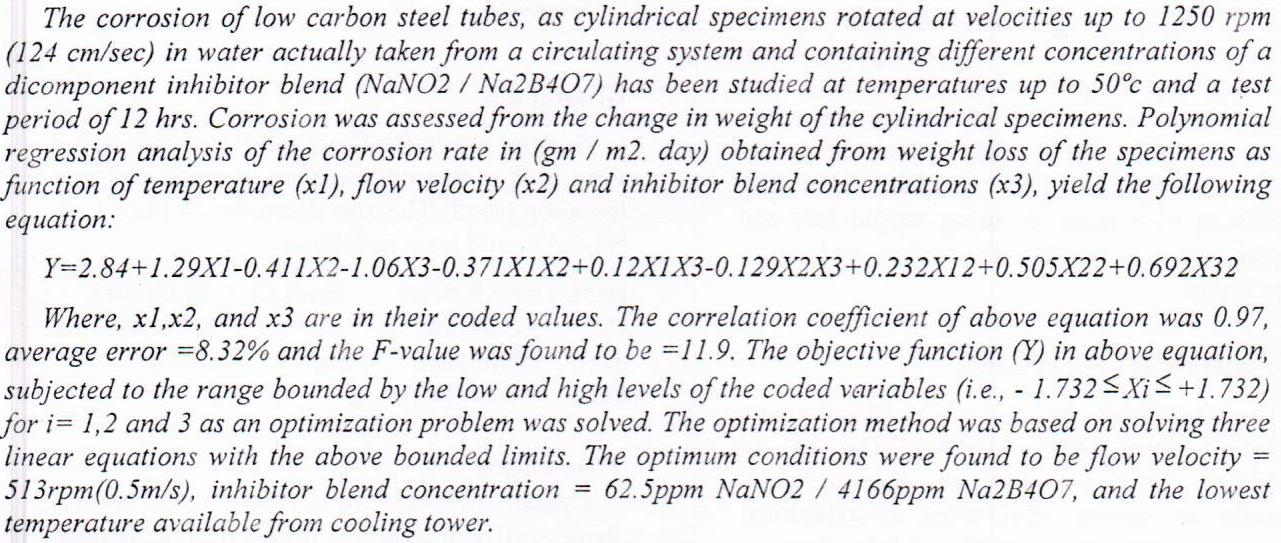
In the current study, CuAl0.7In0.3Te2 thin films with 400 nm thickness were deposited on glass substrates using thermal evaporation technique. The films were annealed at various annealing temperatures of (473,573,673 and 773) K. Furthermore, the films were characterized by X-ray Diffraction spectroscopy (XRD), field emission scanning electron microscopy (FESEM), atomic force microscopy (AFM), and Ultra violet-visible (UV–vis). XRD patterns confirm that the films exhibit chalcopyrite structure and the predominant diffraction peak is oriented at (112). The grain size and surface roughness of the annealed films have been reported. Optical properties for the synthesized films including, absorbance, transmittance, dielectric constant, and refr
... Show More (8)
(8)
 (6)
(6)
 (8)
(8)
 (6)
(6)
a porentioncsisteve has been carried out of the corrosion behavior of inconel(600) in chloride ions (Cl) over the tempreatures 293 over the temperatures 308K in both the dcacrated and the alloy
Hypothesis Nanofluid flooding has been identified as a promising method for enhanced oil recovery (EOR) and improved Carbon geo-sequestration (CGS). However, it is unclear how nanoparticles (NPs) influence the CO2-brine interfacial tension (γ), which is a key parameter in pore-to reservoirs-scale fluid dynamics, and consequently project success. The effects of pressure, temperature, salinity, and NPs concentration on CO2-silica (hydrophilic or hydrophobic) nanofluid γ was thus systematically investigated to understand the influence of nanofluid flooding on CO2 geo-storage. Experiments Pendant drop method was used to measure CO2/nanofluid γ at carbon storage conditions using high pressure-high temperature optical cell. Findings CO2/nano
... Show More (73)
(73)
 (74)
(74)
Photorefractive keratectomy (PRK) is the refractive technique that began with a physical scraping of the epithelial layer of cornea subsequent by laser treatment. Post this procedure to about 48 hours the removed epithelial layer regenerated to protect the eye again. The regeneration process (called re-epithelization) started from the limbus of the cornea toward the central part of it. The re-epithelization mechanism consists of a change in cell density (mitosis) and cell concentration (migration) with a velocity in two directions: radial and tangential. In the present study, an estimation for both radial (responsible for the overlapped layers toward the outward direction of the cornea) and tangential comp
... Show MoreUnderstanding the compatibility between spider silk and conducting materials is essential to advance the use of spider silk in electronic applications. Spider silk is tough, but becomes soft when exposed to water. Here we report a strong affinity of amine-functionalised multi-walled carbon nanotubes for spider silk, with coating assisted by a water and mechanical shear method. The nanotubes adhere uniformly and bond to the silk fibre surface to produce tough, custom-shaped, flexible and electrically conducting fibres after drying and contraction. The conductivity of coated silk fibres is reversibly sensitive to strain and humidity, leading to proof-of-concept sensor and actuator demonstrations.
 (139)
(139)
 (137)
(137)
A solar updraft tower power plant (solar tower) is a solar thermal power plant that utilizes a combination of solar
air collector and central updraft tube to generate an induced convective flow which drives pressure staged turbines to generate electricity.
This paper presents practical results of a prototype of a solar chimney with thermal mass, where the glass surface is replaced by transparence plastic cover. The study focused on chimney's basements kind effect on collected air temperatures. Three basements were used: concrete, black concrete and black pebbles basements. The study was conducted in Baghdad from August to November 2009.
The results show that the best chimney efficiency attaine
... Show MoreCanonical correlation analysis is one of the common methods for analyzing data and know the relationship between two sets of variables under study, as it depends on the process of analyzing the variance matrix or the correlation matrix. Researchers resort to the use of many methods to estimate canonical correlation (CC); some are biased for outliers, and others are resistant to those values; in addition, there are standards that check the efficiency of estimation methods.
In our research, we dealt with robust estimation methods that depend on the correlation matrix in the analysis process to obtain a robust canonical correlation coefficient, which is the method of Biwe
... Show MoreBackground: The objectives of this study are to evaluate the effect of addition of Multi-Wall Carbon Nano Tubes (MWCNTs) of different concentrations (0.05 mg.mL-1,0.25 mg.mL-1,0.5 mg.mL-1and1 mg.mL-1) on dimethyl sulphoxide DMSO and distilled water (DW) on tooth enamel. It intends to evaluate enamel microhardness in (Kg. m-2) pre and post the application of Multi-Wall Carbon Nano Tubes (MWCNTs). Materials and Methods: Thirty specimens prepared for the present study to measure the hardness of the enamel. Results: The results showed that a significant increase in the enamel microhardness for groups 0.05 mg/mL (group B), 0.25 mg/mL (group C), 0.5 mg/mL (group D) and 1 mg/mL (group E) compared with control group (group A) in dimethyl sulphoxi
... Show More (3)
(3)
